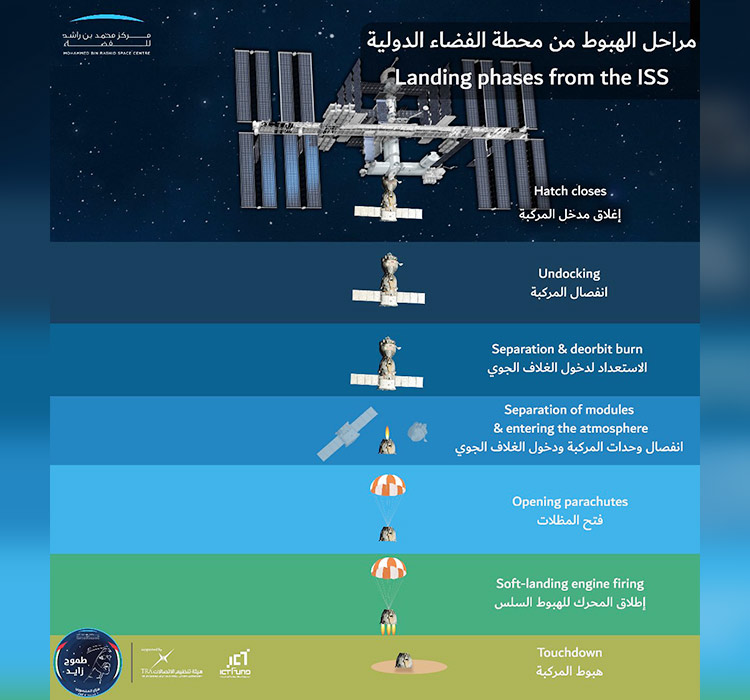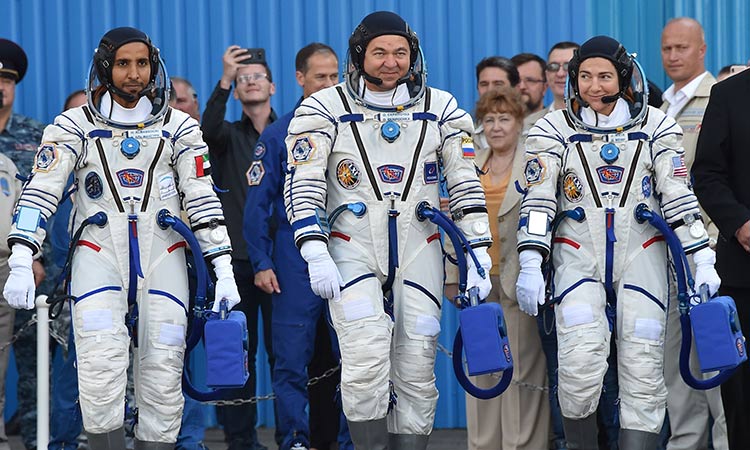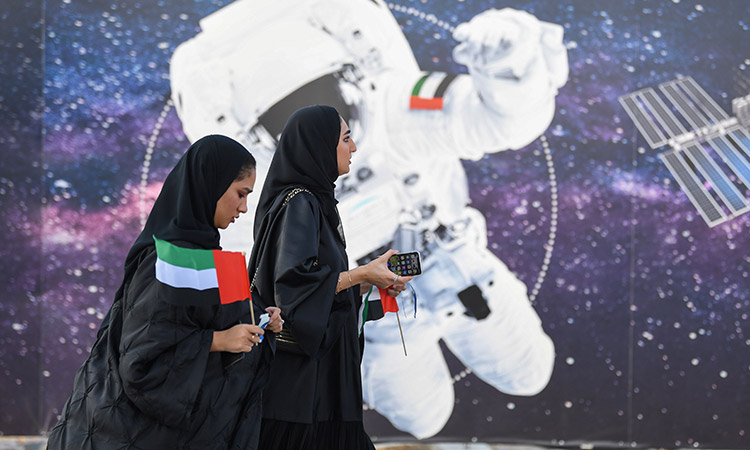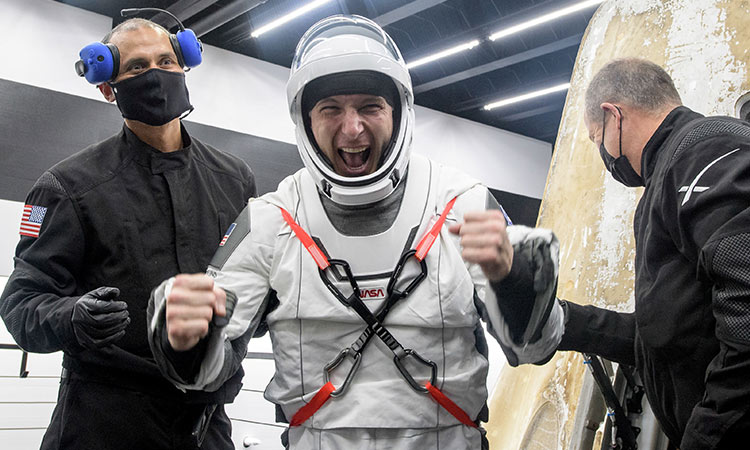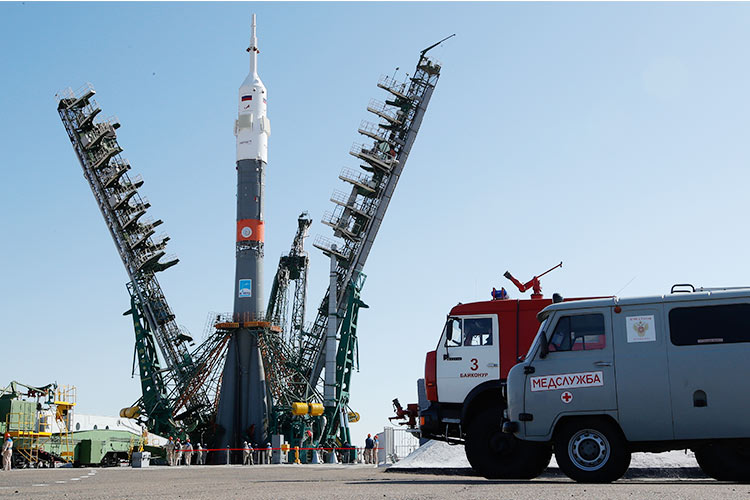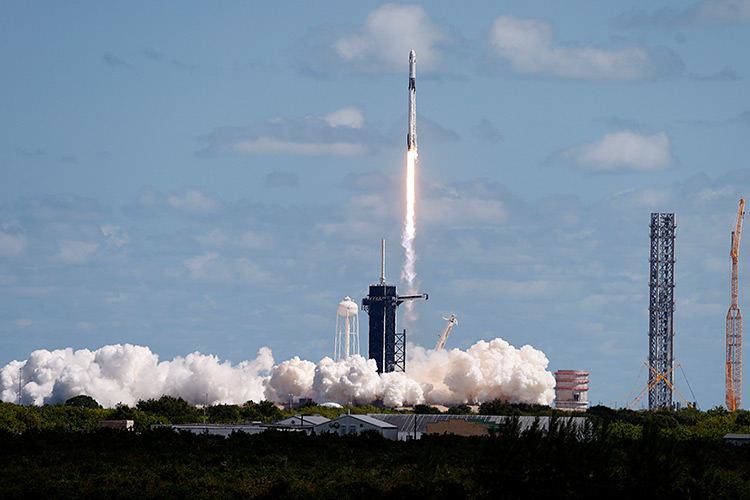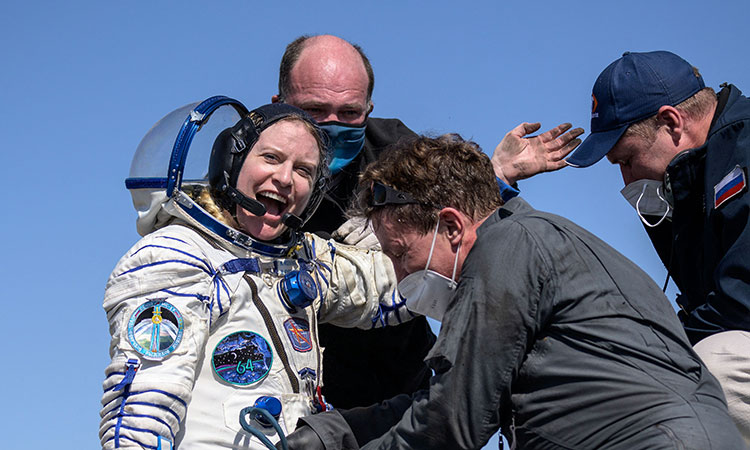VIDEO: UAE bursts with joy as Hazzaa returns from ISS

Hazzaa Al Mansoori (left), Alexey Ovchinin, Nick Hague sit in chairs shortly after the landing. AFP
Emirati astronaut Hazza Al Mansoori has returned to Earth following his eight-day mission on board the International Space Station (ISS).
Al Mansoori touched down safely in the Soyuz MS-12 descent module in Kazakhstan on Thursday.
Hazzaa Al Mansoori of the United Arab Emirates returned to earth along with NASA astronaut Nick Hague and Roscosmos cosmonaut Alexey Ovchinin, who both survived a failed launch to the ISS last year.
Roscosmos, the Russian space agency, confirmed a successful undocking from the ISS at 0737 GMT.
UAE leaders took to social media to congratulate Hazzaa Al Mansoori on his safe return to earth after spending eight days at ISS.
His Highness Sheikh Mohammed Bin Rashid Al Maktoum, Vice Presdient and Prime Minister of the UAE and Ruler of Dubai, tweeted “we thank God for the arrival of the son of the UAE Hazza Al Mansouri safely to Earth after the first flight of an Arab astronaut to the International Space Station ... proud of the achievement.”
“Praise be to God for Hazza Al Mansouri's safe return to Earth after visiting the International Space Station. Congratulations to the people of the UAE for this historic achievement. Zayed's sons will fulfill our ambition to reach Mars’” tweeted His Highness Sheikh Mohamed Bin Zayed Al Nahyan, Crown Prince of Abu Dhabi and Deputy Supreme Commander of the UAE Armed Forces.
Sheikh Hamdan Bin Mohammed Bin Rashid Al Maktoum, Crown Prince of Dubai also took to his twitter account to greet HAzza
“All congratulations to Brother Hazza Al Mansouri on his safe return to Earth at the end of a historic journey represents a strong start to the UAE's entry into the field of space discovery.
“The journey is the starting point for a new journey towards the future with determination to exceed expectations and achieve the highest levels of excellence as a true partner in making a future that holds the best for humanity and ensures the people of the UAE and the people of the region further prosperity, progress and prosperity,” Hamdan tweeted further.
United Arab Emirates specialists carry Hazzaa Al Mansoori shortly after the landing. AP
Hague and Ovchinin are completing a 203-day mission aboard the lab while Mansoori's two crewmates from the September 25 launch -- Russia's Oleg Skripochka and NASA's Jessica Meir -- will stay on as part of a six-member team.
Although Mansoori's mission was short -- eight days in total -- it has still been the source of great pride in the UAE, a newcomer to the world of space with ambitions to send an unmanned probe to orbit Mars by 2021.
Mansoori has been active on Twitter where he posted photos of the UAE and Makkah — Islam's holiest site — from the space station.
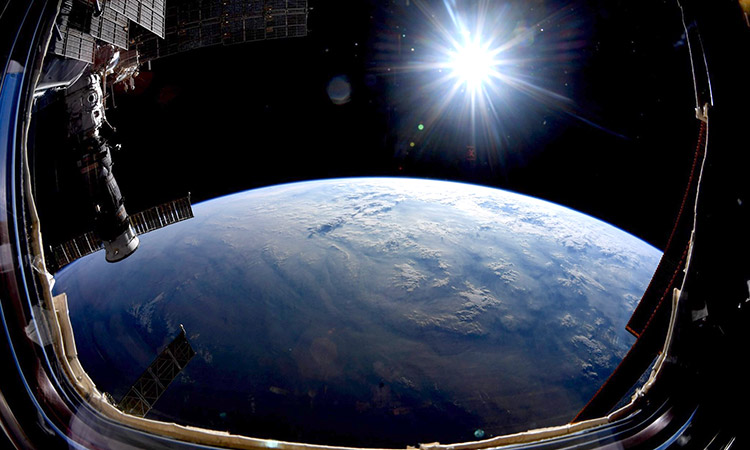
This photo shows a photo by astronaut Nick Hague as he prepares to conclude his stay aboard. AFP/NASA
On Thursday he posted a view of space from inside the space station's famous Cupola module and paid tribute to UAE founding father Sheikh Zayed.
"With fear and pride, I am returning with Zayed's ambition achieved. We are not done yet, and we will never be. To bring back the golden era of Arab astronauts," he wrote.
Mansoori's blast-off from the launchpad that sent Soviet cosmonaut Yuri Gagarin into space was roared on by a large crowd at the Mohammed Bin Rashid Space Centre in Dubai, where he has been feted as a hero.
Dubai's Burj Khalifa, the world's tallest skyscraper, was lit up at the moment of the launch.
The 35-year-old former military pilot's whirlwind mission has had wall-to-wall coverage in Arab media.
UAE sets sights on Mars
The first Arab in outer space was Saudi Arabia's Sultan bin Salman Al-Saud, who flew on a US shuttle mission in 1985.
Two years later, Syrian air force pilot Muhammed Faris spent a week aboard the Soviet Union's Mir space station.
As part of its space plans, the UAE has also announced its aim to become the first Arab country to send an unmanned probe to orbit Mars by 2021, naming it "Hope".
While on board Mansoori donned Emirati dress, treated crew members to local snacks and participated in scientific experiments including a time-perception study that saw him sport a blindfold.
In a question-and-answer session with Emirati schoolchildren, the father of four said a call to his mother would be his top priority at the end of his journey of just over three hours.
The return from space of Ovchinin and Hague will also be watched closely, a year after they failed to launch in the first accident of its kind in Russia's post-Soviet history.
The two men took off in a Soyuz rocket for the ISS in October 2018, but an accident minutes after blast-off sent them plunging back to Earth.
The pair launched again -- this time without hiccups -- to begin Ovchinin's second and Hague's first mission aboard the ISS in February.
The ISS -- a rare example of cooperation between Russia and the West -- has been orbiting Earth at about 28,000 kilometres (17,000 miles) an hour since 1998.
The MBRSC has planned for a grand welcome for Al Mansoori in the UAE.
Earlier in the day, Al Mansoori took incredible images of the UAE illuminating at night from the International Space Station. The image clearly reveals the UAE landmarks, including the Palm Jumeriah and the Zayed Port also called the Mina Zayed of Abu Dhabi.
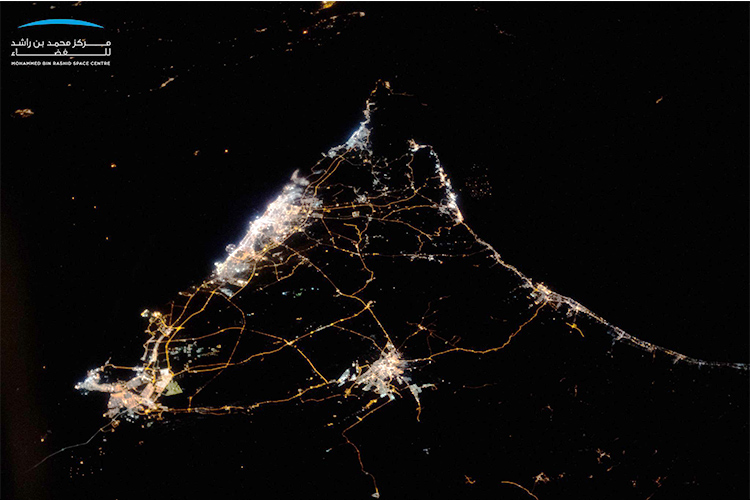
Hazzaa captures illuminating photo of UAE from ISS.
He also shared detailed photographs of Makkah from ISS. On a lighter note, Al Mansoori also shared a couple of selfies aboard the ISS.
He experimented with the autonomic regulation of cardiovascular system, Central Description Haemodynamics, and the influence of space flight factors on the spatial distribution of the energy of heart contractions.
While in the UAE, the Central Bank of the UAE, CBUAE, has announced that it will be issuing a commemorative coin in celebration of Al Mansoori.
Expedition 60 Commander Alexey Ovchinin handed over station control to ESA (European Space Agency) astronaut Luca Parmitano during a change of command ceremony on Wednesday.
The crew change took place onboard the ISS. ISS-60 mission Commander Ovchinin (took up the position since June 2019) and ISS-61 Commander NASA astronaut Luca Parmitano signed the authority transfer act. The crew change at the station is a formal ceremony of signing the respective documents by both the commanders. The number of the mission changes at the very same time – in this case from the 60th to the 61st. The crew has a special tradition to mark the transfer — ringing the bell located in the American segment of the station.
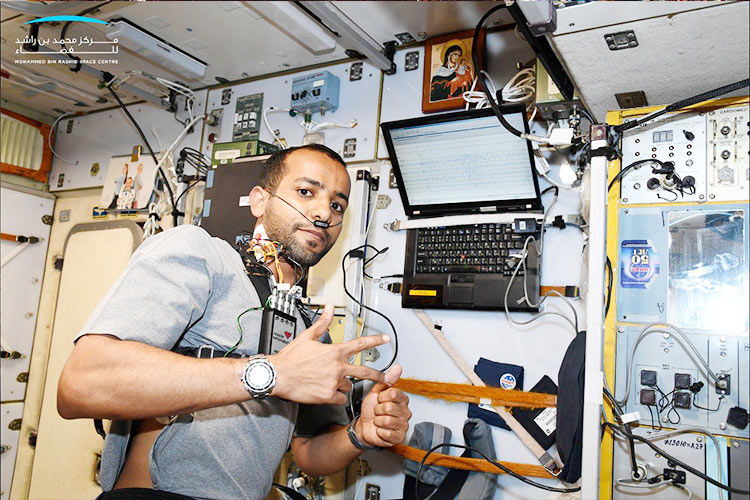
Parmitano will be managing the ISS-61 international team until its returning to Earth, which is expected in February 2020. Parmitano took off for his current mission on July 20, 2019 on the Soyuz MS-13 crewed spacecraft.
According to the flight plan, Alexey Ovchinin, Nick Hague and Hazzaa Al Mansoori are preparing for landing. The crew will take back to Earth the returnable equipment and containers with the results of scientific experiments.
The transfer hatches between the Soyuz MS-12 and the ISS are scheduled to be closed at 04:20 UTC (8:20am UAE time), on Oct.3. Undocking is scheduled at 07:37 UTC, (11:37am) the landing – at 11:00 UTC (3pm), approximately 147 km away southeastward from Zhezqazghan (Kazakhstan). All the operations will be broadcast live in the Live Broadcast section of Roscosmos official website.
Alexey Ovchinin and Nick Hague spent 203 days in space (the spacecraft was injected into orbit on March 14, 2019).
EP-19 crew member Hazzaa Al Mansoori came to the International Space Station as the Soyuz MS-15 spacecraft crew member launched on September 25, 2019. He has stayed in space for eight days.
The Central Bank of the UAE said, “His launch marked a significant day in our history as a nation.”
“We also take the time to remember our Founding Father, the late Sheikh Zayed Bin Sultan Al Nahyan, and the pivotal role he played in Hazzaa and UAE’s success. For back in the 1980s, fuelled by a strong desire to have the UAE be a key player in space missions, he sat with NASA astronauts and shared with them his vision. His successor, President His Highness Sheikh Khalifa Bin Zayed Al Nahyan, spared no costs in building on his father’s goals and driving UAE’s progress. This initiative from the Central Bank aims to pay tribute to UAE’s visionary leadership and to recognise Major Hazzaa Al Mansoori’s heroic efforts in realising their ambitions,” according to the statement.
Al Mansoori wore his traditional Emirati dress aboard the International Space Station. He shared photos with his crew members. Al Mansoori had earlier said that he would share Emirati food with his crew members at the ISS.
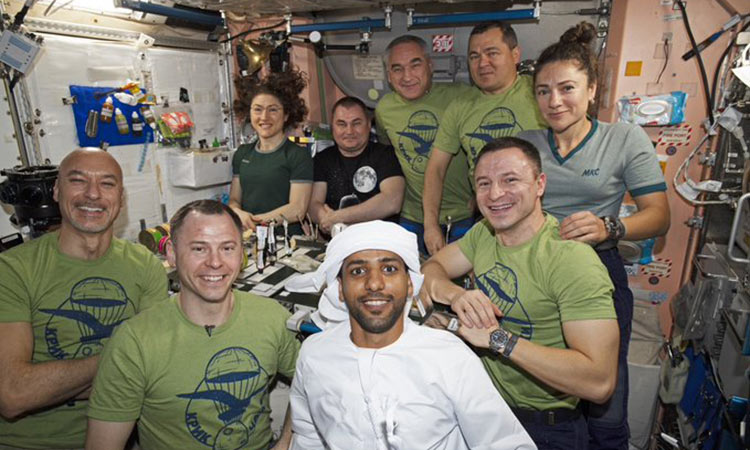
Four Expedition 60 crew members and Al Mansoori gathered inside the Unity module for a meal. Hazzaa had earlier said that he would share Emirati food with his crew members at the International Space Station (ISS). The Mohammed Bin Rashid Space Centre shared a photograph, which showed astronauts Luca Parmitano of ESA (European Space Agency), Christina Koch of NASA, Al Mansoori and NASA astronauts Andrew Morgan and Nick Hague having a feast aboard the ISS.
Al Mansoori is carrying out biochemistry experiments and unloading Japanese cargo with his colleagues aboard the International Space Station.
Astronaut Andrew Morgan said, “After my astronaut classmate Jessica, the UAE’s first astronaut Hazzaa, and Oleg Skripochka arrived last week, our population grew to nine. Great times with a great crew!”
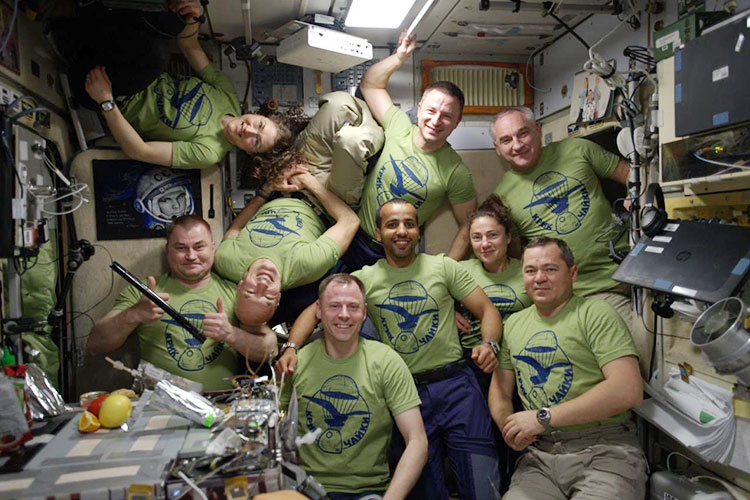
Backup crew member Sultan Al Neyadi said, “While the UAE Falcon Hazzaa Al Mansoori flies with Zayed's ambition onboard the ISS, the MBR Space Centre teams provide support from ground stations in Dubai (UAE), Moscow (Russia), Houston (USA) and Tsukuba (Japan). Great work conducted by Emirati youth.”
Hazzaa Al Mansoori conducted fluidics experiment, which includes validation of fluid behaviour under microgravity. The first part of the experiment addresses technological issues relative to the slosh of fluids during satellite manoeuvres.
Japan’s JAXA'S Int-Ball camera aboard the ISS uses drone technology to provide realtime footage. The drone can be controlled from Earth by the JAXA Tsukuba Space Center.
Japanese astronaut, Satoshi Furukawa, is live from JAXA and playing the role of MC between students at MBRSC event in Dubai and the Int-Ball camera aboard the ISS.
Al Mansoori explained how the Int-Ball camera functions LIVE from the International Space Station.
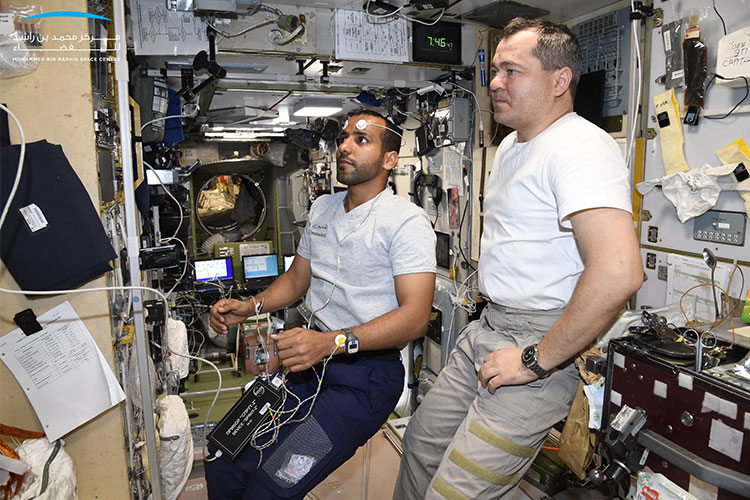
Hazzaa Al Mansoori said: The Int-Ball helps astronauts aboard the ISS take pictures while they are busy.
#AskHazzaa: What are the tasks that are done by robots at the ISS?
Hazzaa: Different robots from different agencies are present in the ISS. Each robot has a different task.
#AskHazzaa: If you could choose a robot to help you with your tasks at ISS, what would it be?
Hazzaa: I would choose something like the JAXA Int-Ball camera, but with forearms.
#AskHazzaa: How do you recognise what's up or down at the International Space Station?
Hazzaa: The ISS deck serves as our reference point for recognising our orientation.
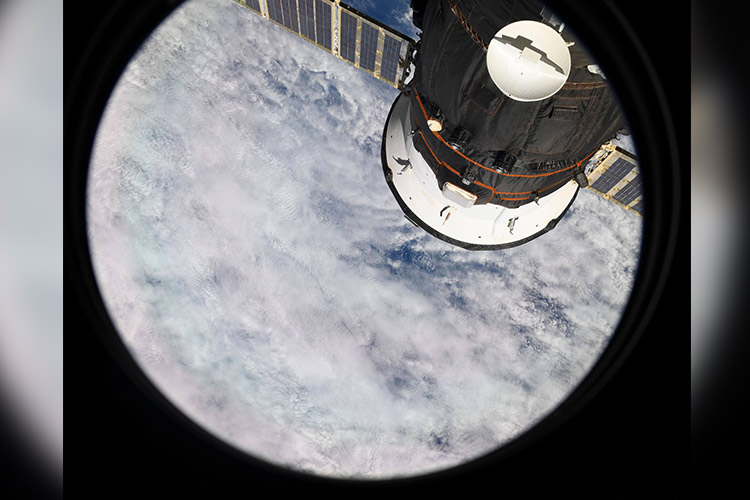
Al Mansoori shared photos from the International Space Station of his experiments. He has undergone an osteology experiment to study bone condition, body composition and the endocrine system in space flight and weighing his body mass as part of the experiment.
He also answered students' enquiries in live session from the International Space Station.
Saud Karmustaji, Director of Strategic Communication at MBRSC: The International Space Station is our gateway to study other planets and prepare to reach Mars.
Karmustaji asked Al Mansoori, “What are the latest updates on the scientific experiments that you are conducting?”
Al Mansoori: I'm conducting experiments on the effects of microgravity on different organs of the human body and other experiments related to blood vessels.
Karmustaji: How are you spending your free time?
AlMansoori: I don't have a lot of free time here, but when I do, I read my favourite book, My Story.
Audience: What is the temperature inside the International Space Station?
Hazzaa: It’s approximately 22 degrees Celsius and we can adjust the temperature whenever we want.
Audience: What is the difference between conducting experiments on Earth and at the ISS?
Hazzaa: At the International Space Station, we carry out experiments in microgravity and compare these results with the results obtained on Earth.
Audience: How do you communicate with your family from the International Space Station?
Hazzaa: During my free time, I can communicate with them through special phones and other different means such as e-mail.
Audience: What is the source of oxygen at the International Space Station?
Hazzaa: Most of the oxygen at the Space Station comes from a process carried out on water.
Audience: Was it difficult to learn the Russian language?
Hazzaa: Learning the Russian language is not easy, but perseverance made it possible. I also taught the crew some words in Arabic.
On his third day aboard the International Space Station (ISS), Al Mansoori began his day by communicating with the ground station at Mohammed Bin Rashid Space Centre (MBRSC), in Dubai, and informing them of his daily schedule.
He then spoke to MBRSC again at the end of the day. A live session via radio was organised between Al Mansoori and school students and the public, at MBRSC, where the audience had the opportunity to ask questions that were answered by Al Mansoori.
During the radio call, Al Mansoori received questions from participants about his daily routine, whether there was enough food at the ISS, how the station was built, how he spent his free time, how he slept, and what astronauts do in case they fall sick.
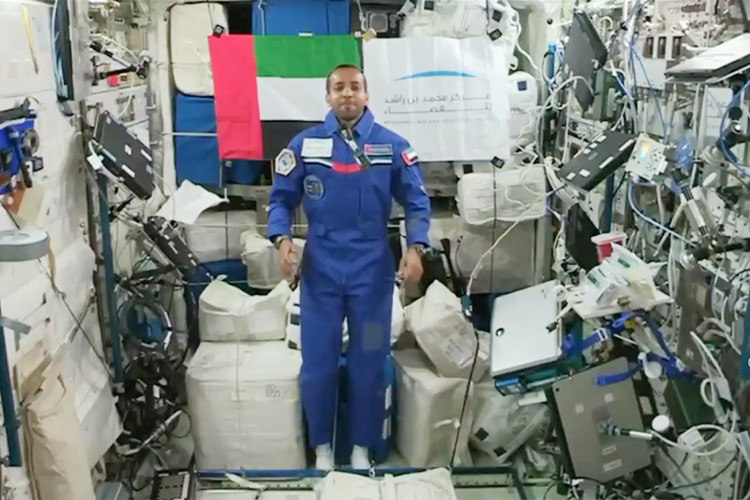
On being asked about food, Hazzaa responded that there was lack of salt on certain foodstuff of his liking. "Astronaut food is limited to a specific number of calories for breakfast, lunch, and dinner. This number is calculated at the ground stations, and food is then sent accordingly to the ISS every two weeks. However, there is spare food in case of failure in arrival," highlighted Al Mansoori.
Al Mansoori explained to them that the day starts at 6 GMT, that is around 10:00 AM Gulf Time, when they receive a daily schedule from the ground stations. "After which, we are given an opportunity to start our personal activities; where we shower and take care of our personal hygiene. Each astronaut aboard the ISS has a different schedule, but we can cooperate on some missions and work together," said Al Mansoori.
"I’m filming everything on the ISS, and these videos will be uploaded to YouTube as well as other communication channels," added Al Mansoori.
Al Mansoori stressed that there are medicines for all diseases aboard the station. In case an astronaut falls sick, we communicate with a doctor who is available around the clock at the ground station to prescribe the appropriate medicine. He also noted that the station is currently disease-free.
Al Mansoori explains his unusual sleeping position. In the space, with the absence of gravity, everything is weightless. He said, "Some astronauts enjoy sleeping with their bodies attached to a wall in ISS, others enjoy sleeping while floating. As for me, I enjoy sleeping while floating."
As for how he spends his free time, Al Mansoori said that he enjoys looking at the Earth from the ISS during his spare time, and waits until it passes above the UAE, so he can take pictures and share with the ground station.
Al Mansoori also spoke to Dr Hanan AlSuwaidi, the flight surgeon for the mission, who is following his medical status throughout his time in space.
He continued working on an experiment on Fluidics (fluid dynamics in space) in cooperation with the European Space Agency (ESA), to observe how liquids move in weightlessness.
After which, he began the experiments involving schools in the UAE as part of MBRSC’s Science in Space initiative.
The first phase of the initiative witnessed the participation of nearly 16 schools from the UAE. Al Mansoori will also perform three daily experiments to observe the impact of microgravity on seed germination rates, the growth of aquatic organisms, and the oxidisation rates of steel.
Furthermore, Al Mansoori will conduct experiments to study Brain DTI, Osteology, motor control, time perception in microgravity, Fluidics (fluid dynamics in space), and DNAm-Age.
Al Mansoori recorded his diary for 15 minutes to document life aboard the ISS and his activities aboard.
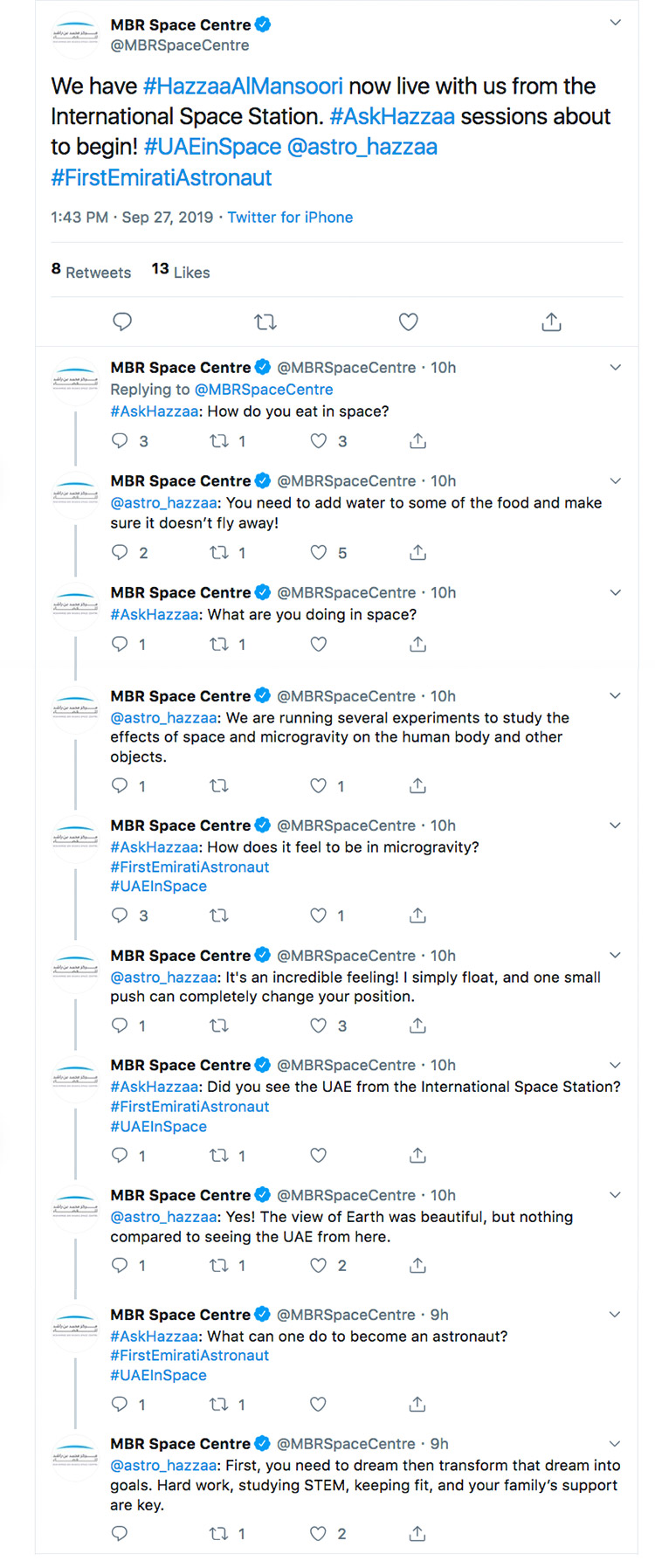
Earlier, he received a video call from His Highness Sheikh Mohammed Bin Rashid Al Maktoum, Vice President and Prime Minister of the UAE and Ruler of Dubai, on his second day aboard the ISS. This step confirms the constant support provided by the UAE’s wise leadership to UAE citizens where ever they are.
Al Mansoori thanked the UAE's wise leadership for their unlimited support to Emirati youth, stressing that he was proud to be the first Emirati to carry the UAE flag into space. He also expressed his ambitions that the experiences carried out by him and his colleagues would contribute to serving humanity.
Mansooris arrival in space is a message to all the Arab youth VP
UAE space mission strengthens our confidence in our youth AD CP
Sheikh Mohammed watches Hazzaa lift-off
Al Mansoori began his missions immediately after arriving safely at the International Space Station (ISS).
He arrived at 2:12am UAE time, on September 26 2019, aboard the Russian spacecraft Soyuz MS-15, along with Russia’s cosmonaut Oleg Skripochka, and US astronaut Jessica Meir.
The Mohammed Bin Rashid Space Centre highlighted that Al Mansoori’s schedule for day 1 was relatively short because the spacecraft arrived at the ISS late the day before. He started his day by praying, then communicating with the team at the ground station in Moscow, and informing them of his daily schedule, and then speaking to Dr. Hanan Al Suwaidi, the flight surgeon for the mission.
MBRSC also said that Al Mansoori recorded a short film about the ISS and his activities aboard, and then recorded his diary for 15 minutes.
Al Mansoori then began the experiments involving schools in the UAE as part of MBRSC’s Science in Space initiative.
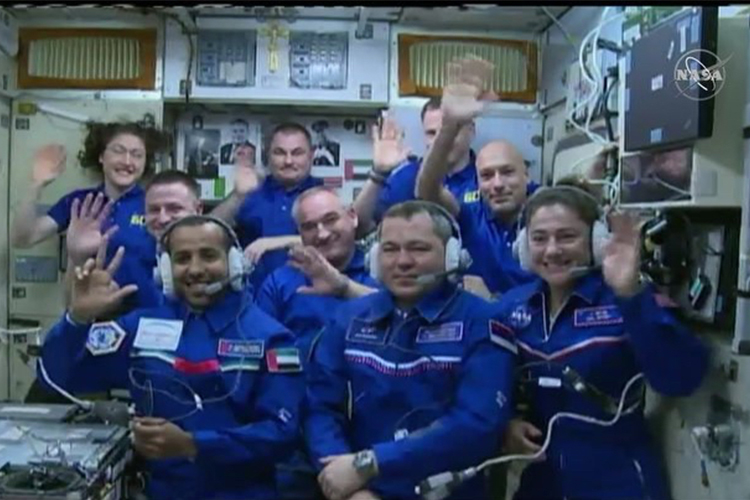
Al Mansoori would also perform three daily experiments to observe the impact of microgravity on seed germination rates, the growth of aquatic organisms, and the oxidisation rates of steel.
Furthermore, Al Mansoori will conduct experiments to study Brain DTI, Osteology, motor control, time perception in microgravity, Fluidics (fluid dynamics in space), and DNAm-Age.
Sheikha Fatima Bint Mubarak, Chairwoman of the General Women's Union, President of the Supreme Council for Motherhood and Childhood, and Supreme Chairwoman of the Family Development Foundation, described the journey of the first Emirati astronaut to space as a historic achievement.
In her statement on the occasion of the arrival of Al Mansoori at the International Space Station, she stressed that this achievement was accomplished due to the Founder of the UAE, the late Sheikh Zayed Bin Sultan Al Nahyan, who empowered the Emirati people to lead in all areas.
She added that this Emirati success is also a positive message sent to all Arab youth, noting that it will strengthen the confidence of the leadership in the Emirati youth and will help achieve the UAE’s promising future ambitions.
Mansooris arrival in space is a message to all the Arab youth: VP
UAE space mission strengthens our confidence in our youth: AD CP
The Soyuz MS-15 successfully docked with the ISS, six hours after its launch. After two hours of safety checks inside the spacecraft, the hatch between the Soyuz and the station was opened to receive the astronauts.
Six astronauts are currently on board the ISS; Christina Koch, Andrew Morgan, Nick Hague, Aleksandr Skvortsov, Aleksey Ovshinin, and Luca Parmitano. The station will include a total of nine astronauts upon the arrival of the new crew.
Hamad Obaid Al Mansoori, Chairman of MBRSC, said, "I’d like to thank the UAE’s wise leadership for their vision and guidance, and for the continuous support that we receive from H.H. Sheikh Hamdan Bin Mohammed Bin Rashid Al Maktoum, Crown Prince of Dubai and Chairman of the Mohammed Bin Rashid Space Centre.
“Today, for the first time, an Emirati astronaut travels to the ISS, carrying the ambitions of the entire Arab region. We congratulate him and congratulate ourselves for being blessed with a country that motivates its youth to reach the highest positions and achieve their aspirations, by supporting them and turning their dreams into a reality that would make every Emirati proud."
Yousuf Hamad Al Shaibani, Director-General of MBRSC, said, "We are proud to be witnessing the beginning of the UAE's first human spaceflight after a long preparation and planning period. Today, Hazza Al Mansoori begins his scientific mission aboard the ISS, which is the objective of this mission."
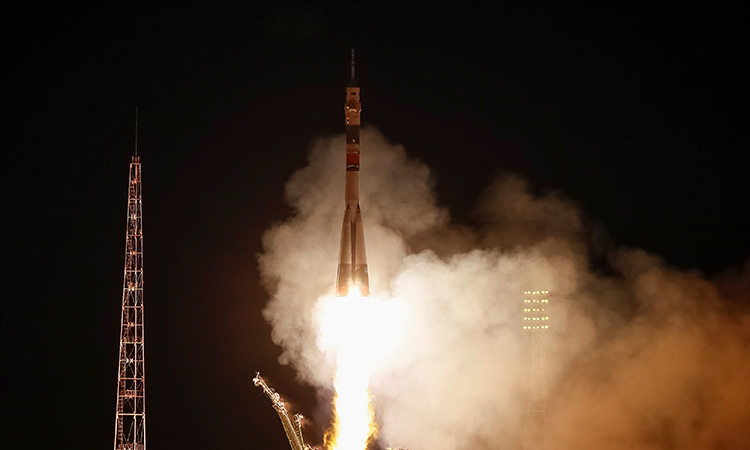
The Soyuz MS-15 spacecraft blasts off to the ISS from the launchpad at the Baikonur Cosmodrome, Kazakhstan. Reuters
"Hazza Al Mansoori is not just the first Emirati astronaut, he has become the UAE's ambassador in space. After the arrival of our ambassador at the station and the completion of the mission, the UAE will play a major role in providing the global scientific community with answers related to scientific topics, such as the impact of microgravity on the human body in the Arab region." added Al Shaibani.
Salem Al Marri, Head of the UAE Astronaut Programme, said, "Al Mansoori’s schedule aboard the ISS will be packed with tasks and activities for all segments of society – children, school and university students, the scientific community, researchers, and others. We are confident that Al Mansoori is ready to do his job, and we will constantly be communicating with him during this period."
MBRSC confirmed that the docking took place six hours after the launch. The Soyuz began orbital manoeuvres to get the right orientation to the desired orbit, and entered Earth’s orbit while increasing altitude and reaching the ISS at approximately 408km.
The Soyuz MS-15 spacecraft located the ISS using the Kurs docking navigation system, when it was nearly 400 km away, and then fixed its orientation towards the station about 180km away.
The docking process was fully automated, and the crew’s main task during the automated docking procedure was to monitor the systems, analyse information about the Soyuz alignment to the ISS, and information about distance, direction and speed, so that they can monitor the process accurately, to ensure a nominal docking operation.
In the final stage, once docking was complete, the locks were tightened, and the seal and vacuum tests were carried out to detect any air leakage, and to ensure that the docking compartment was sealed tight. After two hours, and with confirming that everything worked to plan, the hatch was opened, and Al Mansoori and the two astronauts moved on to the ISS.
Hazzaa Al Mansoori, Oleg Skripochka and Jessica Meir get ready to board Soyuz MS-15 at the Baikonur cosmodrome. AFP
Al Mansoori will conduct 16 scientific experiments in cooperation with international space agencies, including the Russian Roscosmos, the European Space Agency, ESA, and NASA. Six of these experiments will be done aboard the ISS to study Brain DTI, osteology, motor control, time perception in microgravity, Fluidics (fluid dynamics in space), and DNAm-Age. Some of these results will be compared with previous results taken prior to the mission.
The scientific mission includes experiments involving schools in the UAE as part of MBRSC’s Science in Space initiative. The first phase of the initiative witnessed the participation of nearly 16 schools from the UAE, in the presence of Al Mansoori. These experiments will be conducted in a microgravity environment aboard the ISS and the results will be compared with those done on earth, as part of supporting the UAE curriculum with new scientific materials.
Al Mansoori will also be conducting a tour of the ISS to explain the components of the station and the equipment on board. Furthermore, he will read a children’s story, take photos of planet Earth, and showcase the winning entries of the ‘Send to Space’ competition, including stories, poems, and paintings.
Women walk past an illustration depicting an astronaut with the Emirati national flag in Dubai. AFP
MBRSC and Emirates Foundation are offering school and university students and the public the opportunity to participate in live video or radio sessions, with Al Mansoori while on board the ISS, from MBRSC’s headquarters.
A team from MBRSC, which includes Sultan Al Neyadi, and is headed by Salem Al Marri, Head of the UAE Astronaut Programme, will contact Al Mansoori, during his mission, twice a day from the Mission Control Centre in Moscow, to review the mission’s progress, and confirm Al Mansoori’s daily schedule aboard the ISS.
Hazza Al Mansoori’s ISS mission is part of the UAE Astronaut Programme, which is overseen by the Mohammed Bin Rashid Space Centre. The UAE Astronaut Programme is the first integrated programme in the Arab region to prepare national cadres to participate in human space flights and carry out various scientific missions, in addition to becoming a part of the research carried out by the global scientific community to devise solutions to many challenges facing humanity.
The UAE Astronaut Programme is funded by the ICT fund of the TRA. Launched in 2007, the fund, which is the first of its kind in the Arab world, aims to support research and development within the ICT sector in the UAE, to help it grow into a nationally significant and world-leading industry.
Roscosmos State Space Corporation tweeted, “The Soyuz-FG rocket with the Soyuz MS-15 spacecraft was transported to the launch complex. The day one works have begun with the rocket and space industry specialists performing final technological operations.”
“The launch is scheduled for September 25 at 13:57 UTC.”
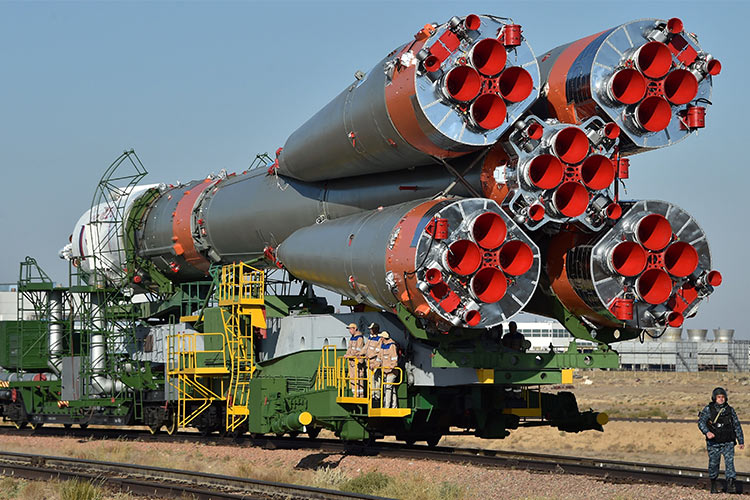
The Emirati astronaut who will make history by becoming the first Arab on the International Space Station (ISS) said on Tuesday that he had received support from around the world before his “dream” mission.
Hazzaa, 35, blasted into space accompanied by Russia’s Oleg Skripochka and Nasa astronaut Jessica Meir onboard a Soyuz rocket from Baikonur in Kazakhstan on Wednesday.
Hazzaa, who will spend eight days on the ISS, will be the first Emirati astronaut and the first Arab on the orbiting laboratory.
“It is really an honour and we are looking forward to make this mission successful and to come back with a lot of knowledge,” the pilot told a pre-flight news conference.
He said the trip was a milestone for his country and the Arab world.
“This achievement will be in history and it will be continued,” he said.
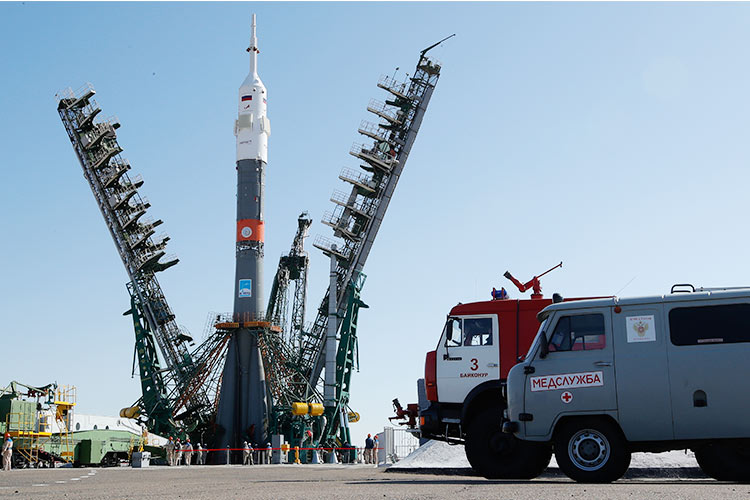
“The dream has come true.”
Hazzaa said that he would record his prayer routine on the ISS and broadcast it to people on Earth.
“As a fighter pilot I already prayed in my aircraft,” he said, explaining that he had experience of prayers at high speed.
Hazzaa also plans to conduct experiments and said he would take Emirati food with him to share with the crew.
Skripochka, first-time flyer Meir and Hazzaa will join a six-member crew on the ISS and for a brief period of time the ISS will be home to nine astronauts.
Meir, 42, said it was “quite an achievement” for the United Arab Emirates to have a man in space, given that its programme is so new.
She said the crew communicated by using “Runglish” — a mixture of Russian and English.
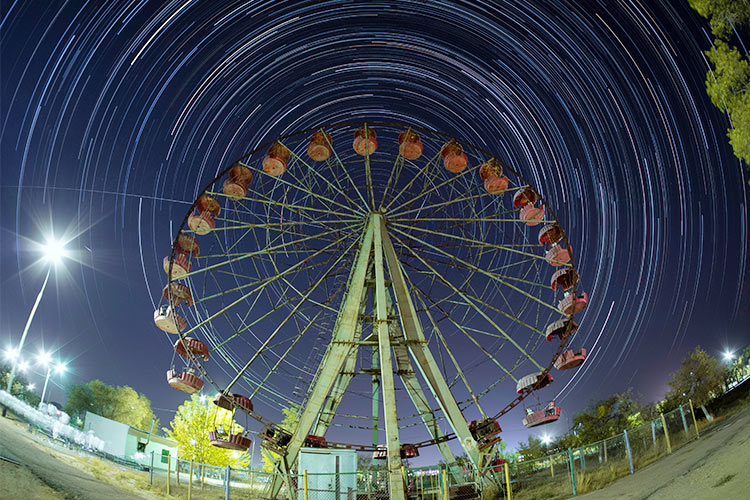
“We still need to work on our Arabic,” she joked.
Hazzaa is set to return to Earth with NASA’s Nick Hague and Russian cosmonaut Alexey Ovchinin on Oct.3.
Skripochka and Meir are set to remain on the ISS until the spring of 2020.
Agencies
PLANNED FLIGHT DURATION
— 187 days
The Soyuz MS-15 prime crew
includes Roscosmos
cosmonaut Oleg Skripochka (commander), NASA
astronaut Jessica Meir (flight engineer) and UAE astronaut
Hazzaa Al Mansoori.
THE BACKUP CREW
Roscosmos cosmonaut
Sergey Ryzhikov, NASA
astronaut
Thomas Marshburn and
UAE astronaut
Sultan Al Neyadi.
ISS-61/62 MISSION MAIN TASKS.
• ISS-61/62/EP-19 crew injection into orbit on the Soyuz MS-15 spacecraft;
• Soyuz MS-15 approach to the ISS according to the four-orbit scheme and its docking to the Zvezda module;
• Fulfilling Russian applied scientific research and experimental programme;
• Fulfilling the experimental programme of the EP-19 space flight participant (UAE);
• Joint work with ISS-60/61 and ISS-62/63 crews;
• Loading and undocking of the Soyuz MS-13 from the Poisk module (return of two Soyuz MS-13 and one Soyuz MS-13 crew members);
• Work with Progress MS cargo ships (docking and unloading, loading and undocking);
• Station workability support;
• Spacewalking activities;
• Soyuz MS-16 approach to the ISS;
• Soyuz MS-15 loading and undocking (return of two Soyuz MS-15 and one Soyuz MS-13 crew members).
SOYUZ-FG CARRIER ROCKET
The medium class Soyuz-FG carrier rocket was developed and manufactured at the Progress Rocket Space Centre (Samara). The rocket is meant to inject Soyuz family crewed spacecraft into Earth’s orbit, progress family cargo vehicles according to the International Space Station programme. This will be the 70th and the final launch of the Soyuz-FG carrier rocket.
• The only carrier rocket in the world for launching crewed spacecraft to the ISS.
• Environmentally friendly fuel components — kerosene and liquid oxygen.
• One of the most reliable carrier rockets in the world

